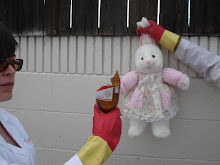 Potassium lives all the way on the left side of our periodic table in a category known as the Alkali Metals. The definition of alkali is “a hydroxide which dissolves in water to form a solution with a pH greater than 7; capable of neutralizing an acid.” A solution that is highly basic can be just as dangerous as a solution that is highly acidic. If you reach way way back into the memory of your 7th grade chemistry class (and ignore the boredom and embarrassment you probably experienced in said class) you’ll remember that acids and bases neutralize one another. I'm sorry you had to delve back to such an unpleasent time. Go to your happy place, go to your happy place.
Potassium lives all the way on the left side of our periodic table in a category known as the Alkali Metals. The definition of alkali is “a hydroxide which dissolves in water to form a solution with a pH greater than 7; capable of neutralizing an acid.” A solution that is highly basic can be just as dangerous as a solution that is highly acidic. If you reach way way back into the memory of your 7th grade chemistry class (and ignore the boredom and embarrassment you probably experienced in said class) you’ll remember that acids and bases neutralize one another. I'm sorry you had to delve back to such an unpleasent time. Go to your happy place, go to your happy place.Alkali Metals have an atomic configuration that makes them want to give up an electron. This quality them very very reactive. So reactive in fact that they must be stored in mineral oil for fear that they will react with any moisture lingering in the air. All Alkali Metals are reactive with water, and they become more so as you move down the column of the periodic table. Sodium is more reactive than Lithium, Potassium is more reactive than Sodium and Rubidium and Cesium, forget about it. Potassium, especially, is HILARIOUSLY explosive when it comes in contact with water. Just look at what this idiot ended up doing:
I can't tell how much potassium went in there, but it was probably an amount no bigger than a dime. Now, I’m all for reckless science (obviously), but this instructor could’ve gotten seriously hurt, or injured her students or blown up her classroom completely. Alkali Metals, in their purest form, are nothing to fuck around with. Luckily, you’ll almost never find pure sodium or potassium or (God help you) Rubidium unless you’re a chemist and you really need them.
Potassium is found in lots of things, including minerals! Minerals like potassium feldspars, also known as Orthoclase, are frequently found in Granites. Minerals with potassium in them are pretty pretty pink, like this:

One last note about Potassium is that the compound potassium nitrate (KNO3), also known as saltpeter, has a notorious reputation for what it does and does not do to the human body. Saltpeter is one constituent of black power gunpowder, but if urban legends are correct, was also used as an anaphrodisiac everywhere from mental institutions to sailboats. I'm not aware of any studies that prove or disprove these statements, but if WW2 has any say in it, I'm a believer.
Viva Potassium!!


No comments:
Post a Comment